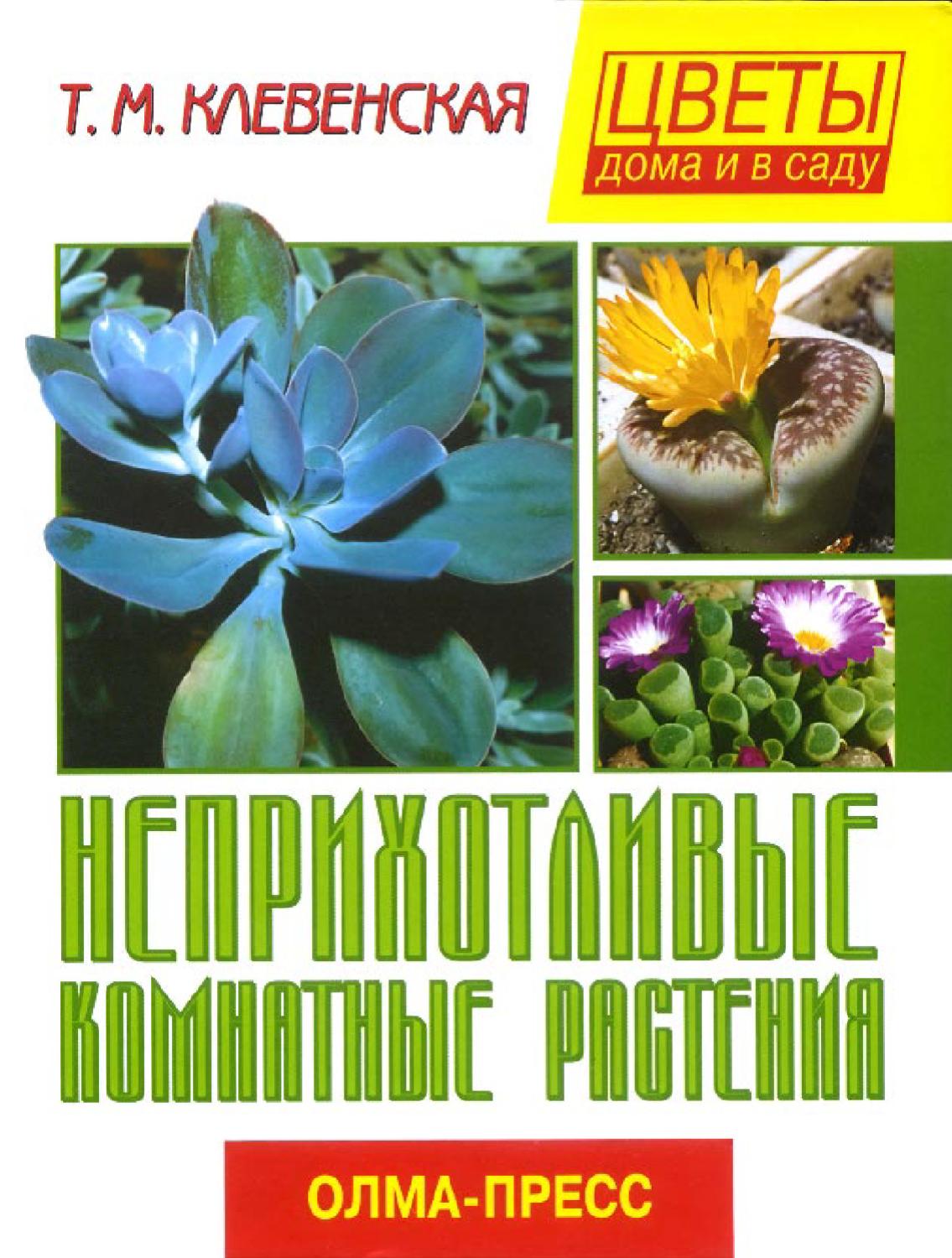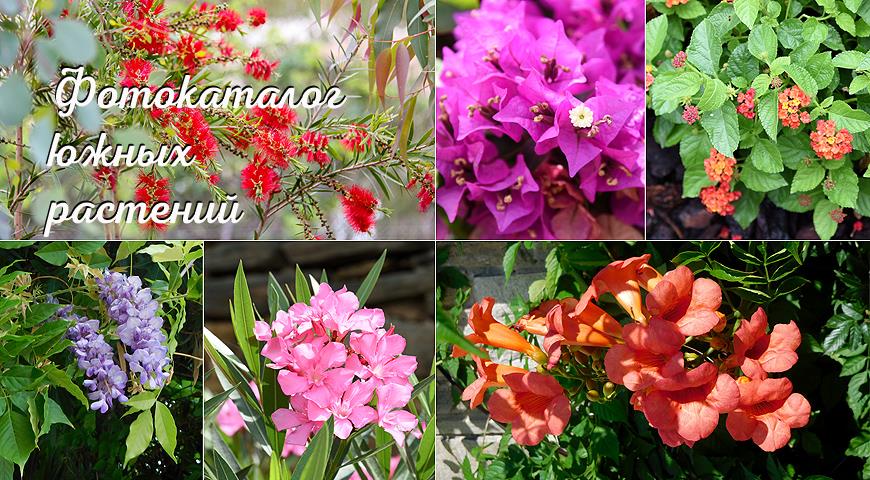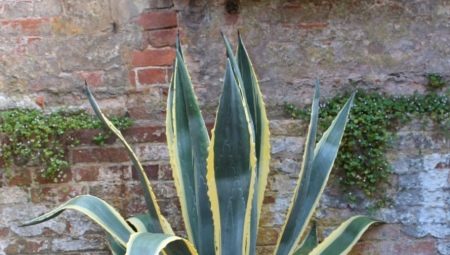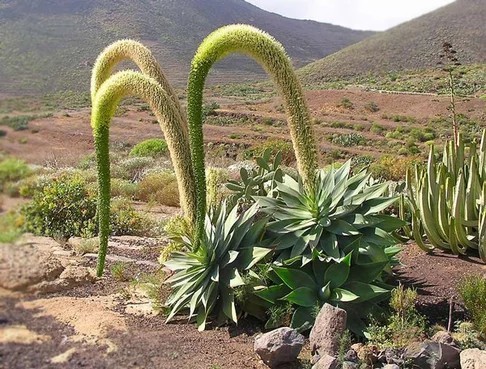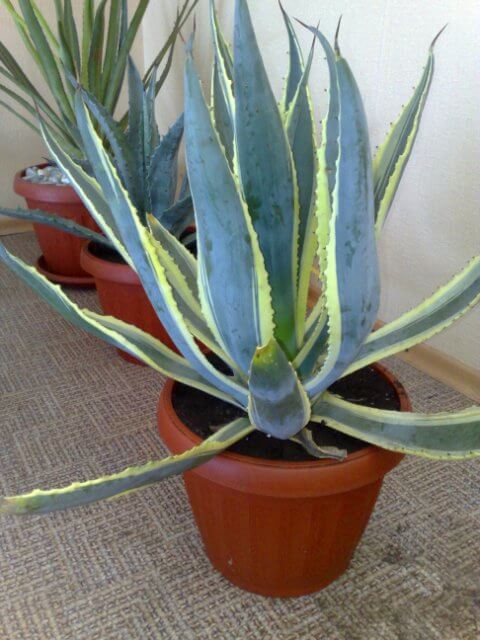Agave care
Agave is an indoor crop, the cultivation of which requires adherence to certain rules. According to experienced florists, for her active growth you need to create the following conditions:
- Location. Grows well on windows from the south or east-south side. No shading is required - the flower reacts calmly to the direct rays of the sun.
- Temperature. In summer, it is easy to create the necessary temperature conditions - the plant feels comfortable at 20-28 ° C. In winter, she needs coolness - about 10 ° C, so for the winter it is better to transfer her to a glazed balcony. Most species withstand short temperature drops to 0 ° C.
- Watering. Water in moderation, avoiding excessive soil moisture. The recommended frequency of watering during the period of active growth is 1-2 times a week. A clod of earth in between waterings should remain slightly moist, it is better not to allow the soil to completely dry out. In winter, the frequency of watering is reduced to 1-2 times a month.
- Humidity. The flower is not picky about humidity - no spraying or additional humidification is required. Grows best in well-ventilated areas.
- Top dressing. In spring and summer, special preparations for cacti are used as top dressing. Let's admit watering with mineral fertilizers with a low nitrogen content. Top dressing is carried out 1 time in 3 weeks. Frequent fertilization will negatively affect growth. In the fall, feeding is stopped.
- Transfer. Young plants require an annual transplant in a larger container. Adult bushes are transplanted less often - once every 2-3 years. Ready-made soil mixes for succulents are suitable for planting. The soil is prepared independently from turf, peat and sand, adhering to equal proportions. To further loosen the soil, add a small amount of brick chips or hydrogel. When transplanting, avoid deepening the neck of the plant - the growth point must remain on the surface.
Agave - what is this flower
The homeland of this beauty is sunny Mexico. There it can be up to 5 meters in diameter. Agave is a plant of the Asparagus family and the Agave subfamily. The people call it the agave. This plant is really long-lived and lives up to a hundred years. The flowering of agave is also interesting - if the plant throws out a peduncle from the center of the outlet, after the fruit ripens, the bush dies completely.
Agave in the wild
A short description of what it looks like
Agave is a succulent and is often confused with cacti and aloe. Species and varieties, and there are about 400 of them, have a variety of sizes and color of leaves. They are united by one sign - a rosette. Its stem is small or not developed at all. Wide xiphoid leaves grow from the outlet. They can be smooth or have spines along the edges, long sharp spines are located at the tips. Foliage color - gray, blue, green-blue, gray-green. Often, the edges of the leaves are decorated with silver or yellow stripes.
Note! A bright decorative accent of agave - a beautifully folded rosette of leaves, symmetrical or spiral
What is made from agave
In Mexico, the agave flower is very popular. Agave as a fruit is used to make juice and to digest syrup, which is used instead of sugar. Local alcoholic drinks are produced from it.
But agave is not only eaten, its leaves are used to make paper, ropes and ropes. Since ancient times, it has been beneficial for medicine. The plant has wound healing properties, relieves inflammation, lowers temperature. Culture juice is an antiseptic.
Why agave is useful for the body
The plant contains several compounds with protective beneficial properties. It contains saponins that bind to cholesterol and can help lower overall cholesterol levels.These compounds can also inhibit the growth of cancerous tumors, which are undoubtedly beneficial.
In cosmetology, agave is used to improve the condition of the facial skin.
Agave also contains inulin, a type of fiber that is a probiotic or beneficial type of bacteria. A natural plant, unlike syrup, also provides the body with a good dose of fiber and a lot of fiber, which can reduce the risk of constipation.
Plant care
Since agave grows well even in the wild without any additional fertilizing and additional watering, many conclude that almost no care is needed for such a plant. However, this is not the case, certain procedures still have to be carried out, since most varieties of blue agave can have a weak immunity to diseases.
- The main requirement is the availability of a sufficient amount of lighting. If there is little light, or the apartment is dark, it is worth purchasing artificial light lamps.
- The temperature can be either hot or cool, here agave "does not impose" any special requirements. But it is advisable to avoid frost.
- As for watering, in the summer the agave is watered once every 7 days, and in the winter - once a month. The temperature does not affect the frequency of watering - all the necessary plant will accumulate in itself on its own.
- Blue agave needs air at any time of the year, so ventilate your rooms frequently. In summer, the plant can be taken out to an unglazed balcony or garden.
- Agave should be fed rarely, and only with granular fertilizers. There should not be a lot of nitrogen in top dressing. By the way, if you don't fertilize the agave at all, it won't grow worse.
- As mentioned above, agave needs sandy soils. It is imperative to add drainage, in addition, it is better if the soil is alkaline, not acidic.
- The container for growing agave is chosen wide, but it should not differ in depth. For this purpose, ceramic pots are the best solution.
- Young specimens are transplanted every year, adults can be moved to a new place every 3 years. In this case, the presence of a root collar above the surface of the substrate becomes a prerequisite. And also do not forget to wear gloves during the transplant - agave juice causes redness and itching of the skin.
- Blue agave is very susceptible to fungal invasion, which causes rotting of roots and leaves. They fight the scourge with fungicides. If the disease is started, all that remains is to throw out the plant. In addition, agave can also suffer from the weevil beetle, thrips, scale insects, and aphids. All of these pests respond well to insecticide treatment.
See the video about Blue Agave below.
Blue agave is a cactus or not
Having seen this plant, many are wondering: the cactus is an agave or not. Outwardly, it looks more like aloe, but does not belong to the type of cactus. The main differences between these two plants are as follows:
- agave has leaves, but cacti lack them;
- in agave, thorns are present only at the tip of the leaf, and cacti are completely covered with them.
Blue agave in the wild
When asked whether an agave is a cactus or not, the answer is unambiguous: it is not considered a cactus.
As for aloe, agave differs primarily in that it does not have a stem, the leaves of the plant are less dense and leathery.
Thus, agave is neither aloe nor cactus. Another significant difference between these plants is that agave belongs to the asparagus family, cactus - cactus, and aloe - asphodelic.
Short description
For Russians, the question of what it is - blue agave is very relevant, since it is rare in our country. This plant grows in the west and east of Mexico at an altitude of more than 1500 meters above sea level. It prefers to grow in dry tropical climates on red earth soil with a high sand content.
Interesting! There are decorative varieties that are not large in size.And there are those who, in comparison with the person standing next to them, look taller and more massive.
Wild differs from the domestic variety in characteristics. Wild agave, like domestic agave, begins its life cycle with intensive growth. Upon reaching the age of five, a shoot appears on the wild variety, the length of which is 5 meters with an inflorescence of yellow flowers. Subsequently, seeds appear in its place, and the wild plant dies off.
Agave leaves at the root are often rosette and appear fleshy in appearance. They are very hard and large and can vary in width. The color of the leaves can be different. Currently, there are over 300 species of agave. They differ in the shape of the leaves and their shades.
The most common are:
- Agave yellow;
- Tequila;
- American;
- Striped;
- Compressed.
It blooms in natural conditions once every 10-15 years, after which it dies.

Mexican agave at home
Using blue agave
Studies have shown that blue agave contains trace elements and compounds that significantly increase the effectiveness of medicines used to treat colitis and Crohn's disease.
In addition, the flower perfectly helps to cope with the following pathologies:
- diseases of the gastrointestinal tract;
- diseases of the respiratory system;
- skin problems;
- burns and frostbite;
- diseases of the urinary system;
- inflammatory pathologies;
- diseases of the spine and joints;
- headache and toothache;
- sexually transmitted diseases;
- overweight problems.
The plant has a number of valuable properties. With the help of it, the nervous system is strengthened, excess fluid is removed from the tissues, and digestion is also improved.
Note! Juice should not be consumed in large quantities, as it contains insulin. As for the domesticated variety, it is rarely used as a home plant, since it is distinguished by its significant size.
As for the domesticated variety, it is rarely used as a home plant, since it is distinguished by its significant size.
Blue agave is a type of agave that is widely used to make an alcoholic beverage called tequila. Many people know a moisturizing mask with this plant, as well as the addition of various fruits to it, which are used in cosmetology. With its help, the tone and elasticity of the skin increases.

Blue agave - raw material for the production of tequila
Agave plant species: photo, name and description
All of them are large in size and have thorns or thorns on the leaves.
Other names: Century plant - century plant (agave), American aloe-American aloe, American sisal - American sisal.
The birthplace of the agave plant is Mexico, Central America, the USA and the Caribbean islands.
The popular popular name agave was given to agave for the delusion that it blooms once every hundred years. American aloe agave is called for the external similarity of these plants, as well as for the same widespread use of agaves in the American continent as aloe in the Old World.
This plant is so widespread in Mexico that the country got its name in honor of the agave - “the place of the agave”.
Agave plantations are cultivated in Mexico, where the plant is not allowed to bloom. When a young bud becomes visible in the middle of the rosette, it is excised. In the formed hole, sweet juice is collected, which was supposed to go to the formation of the stem, flowers and fruits.
This juice contains 10% sugars and in Spanish is called aquamiel, which means "sweet water" or "honey water". This juice is scooped out 3 times a day. The plant is able to produce sap for 8 to 10 months, until the leaves are completely dry. For the entire period from one plant alone, you can collect up to 1000 liters of juice.
Agave reduces the number of pathogens in the air by 69%, as well as fungal spores.
Damage to small blood vessels occurs due to exposure to calcium oxalate crystals and saponins. Treatment is carried out by taking antihistamines and applying saline compresses to the affected areas. Systemic symptoms disappear within a day, and after 7-10 days, skin manifestations also decrease.

Marginata - leaves with golden yellow or whitish yellow edges; Mediopicta - leaves with a yellow stripe in the middle; Striata - Leaves are grayish-green with yellowish-white stripes in the middle.
A. American ‘Mediopicta’ (A. americana ‘Mediopicta’) - cream leaves with green edges.
A. Queen Victoria (A. victoriae-reginae) - leaves are dark green with a white border, at the ends of which are black spines.
A. filamentous (A. fdifera) - the leaves are raised up, the plant is compact, there are thin threads at the ends of the leaves.
A. drawn (A. attenuate).
A. gray (A. perrine).

A. sisal (A. sisalana).
A. angustifolia 'Marginata'.
A. Franzosini (A. franzosinii).
A. bright red (A. coccinea).
In indoor conditions, dwarf forms or young plants are grown.
Tequila production
Blue agave is used as a raw material for making tequila.
In 1902, Franz Weber, a botanist from Germany, came to Mexico. He had to decide which kind of agave is best for making alcoholic beverages.
The scientist made a conclusion, which the local Indians came to long before him: for this purpose it is worth growing a blue agave.
So she also received the name of the scientist and became known as Agave Tequilana Weber.
This type of agave is shaped like a huge rose. Its leaves are fleshy, fibrous, have thorns along the edge and are covered with wax so that a lot of moisture does not evaporate. They are bluish or greenish-grayish in color. Tequila requires only the core of the plant.
Plantation specialists monitor the development of the agave, and when its core stops growing and turns reddish-brown, then all other parts are cut off in the field with a special tool called soy, and the core is sent for processing.
At the plant, the core is steamed, chopped finely and squeezed out.
There is no specific harvest time on the plantations. The cores ripen at different times, and the harvesting work goes on all year round.
Tequila is only produced in Mexico, because the plants to make this drink must grow under certain conditions: the agave fields for tequila are usually located at an altitude of 1500 meters above sea level.
The temperature here fluctuates within 20 degrees, cloudy days should not be more than 100, the level of precipitation is not more than 1 meter per year.
There are also special requirements for the soil: it must be rich in iron and minerals. Some growers prefer blue agave grown on mountain slopes formed by a volcanic eruption.
All these conditions cannot be met in another climate. Namely, they help to end up with transparent tequila with a special delicate aroma.
Despite the long dry periods, agave fields are not irrigated, because in this case the plant grows to a large size, but loses plant sugar, which is important in tequila production
These blue agave plantations are protected by UNESCO. And tequila has become the national drink in Mexico. The country exports it all over the world.
Tequila is widely used as flavoring additives to dishes and soft drinks (nectars and juices).
Blue agave juice, squeezed at the plant, is used not only for the production of tequila, it is also an independent drink.
The juice tastes like honey. It is used by culinary specialists, adding it to the dough (it is also convenient because the juice is easy to ferment), to desserts and various creams.
The juice dissolves easily in any liquid, so various drinks are prepared from it, most often cocktails.
The juice has a thick consistency and is commonly referred to as nectar.There are two types of such nectar, obtained with different degrees of processing of the core.
Light nectar tastes like caramel, dark nectar tastes like molasses and has a delicate aftertaste. In their pure form, both types are used as our jam: they are poured over pastries, added to tea.
Chemical composition and calorie content of agave
Naturally, agave is an excellent source of iron, a mineral that carries oxygen from the lungs to other parts of the body. A hundred-gram portion of a raw plant contains 1.8 mg of iron, and the same amount of dried plant contains 3.65 mg. This represents 46% of the daily value of this mineral for men and 20% for women. All this testifies to the great benefits for the body.
Other beneficial properties are as follows. A serving of raw or cooked agave provides about 40% of an adult's daily calcium requirement, and dried agave provides nearly three-quarters of that. In addition, the plant is a good source of zinc, a mineral essential for wound healing.
The calorie content of the raw plant is 68 kcal per hundred grams. Agave syrup has a much higher nutritional value - 310 kcal per 100 g. It is a moderate source of vitamin C and several B vitamins.
The syrup is composed of 76% carbohydrates, 23% water, 0.4% fat and negligible amount of protein, so it can be harmful to people who are prone to obesity.
What does it look like and where does it grow?
The birthplace of the blue agave is, of course, Mexico. Today, this plant is the pride of a sunny country not only for its interesting external features, but also for its enormous help in agriculture. However, the history of the plant begins long before the development of industry and horticulture.
For the first time, according to legend, the beneficial properties of agave were discovered by Mexican Indians. Then people did not know what kind of strange bushes surrounded their villages. Only by chance, thanks to a thunderstorm, did the settlers discover that the blue agave contains a viscous and incredibly tasty juice. Subsequently, the Indians began to use the juice not only for food, but also for medicinal purposes, but they did not cultivate agave on purpose, since the plants were already in abundance.

But direct cultivation began only in the 1700s, when the Spaniards discovered the agave. It was at that time that they realized that the plant was the ideal raw material for the production of alcohol. By searching for a suitable crop, by cultivating different varieties, the Spaniards came to the conclusion that it was blue agave that was best suited for this purpose. The drink obtained from the core of the plant began to be called "tequila", and the blue agave itself also received a second name - "tequila", which has survived to this day.
The largest blue agave plantations are concentrated in the Mexican state of Jalisco, it grows in Central and South America. Often, blue agave can be found in deserts, while its appearance differs from domesticated for the better. Wild varieties are much stronger and more hardy, their leaves are more powerful, and the core is larger. Agave in nature is so accustomed to the harsh conditions of the desert that it is quite capable of growing on mountain slopes even where there is frozen lava.
As for describing the appearance and qualities of the plant, it should start with the size of the agave. Basically, the culture reaches two meters in height, but near the root its size is much larger - almost 4.5 meters. The plant, as a rule, does not have a stem, but it has a rather large and fleshy rosette, consisting of hard, leathery leaves. The shade of the foliage can vary - in nature, there are both greenish-gray and bluish colors.


The average life span of an agave in its natural environment is 5 years, and it blooms only once in a lifetime. The last stage of the agave's existence is marked by unprecedented beauty - a huge peduncle several meters high appears in the center of the plant, on the top of which small yellow flowers swing.When the flowering period comes to an end, the agave sheds its seed pods and dies.
In terms of plantations, the life expectancy of blue agave is much higher - up to 15 years. This is due to the fact that the peduncle is simply removed and planted in the ground, thus obtaining a new plant. Although this technique allows the plant to live three times longer, it also has its drawbacks. By interfering with the natural order of things, gardeners reduce the agave's immunity, which contributes to its susceptibility to diseases and pests.


Transfer
The pot used should not be too small or too large. He must match the size of the plant. If, after transplantation, spots or yellowness appeared on the leaves, this means that the soil did not fit it, and the development of the root system stopped. In this case, it must be transplanted into another container with new soil again.
When transplanting, children are separated from the mother plant. First, it is removed from the pot by the transfer method.
Then they remove the excess soil on the roots and carefully pick out all the children with a knife. After that, all old and damaged leaves should be removed at the bottom.
 The next step is to remove the beginners to form on the roots of the children. They take a lot of energy from tequila agave and interfere with growth.
The next step is to remove the beginners to form on the roots of the children. They take a lot of energy from tequila agave and interfere with growth.
A plant transplanted to a new place is watered 3 days after transplanting. During this period, the injured roots will dry out, so they will not rot when moisture gets on them.
Description and features
Agave is a perennial succulent plant. A powerful rosette of fleshy leaves with sharp thorns develops around the short stem. When grown in an apartment, they are cut off - the plant calmly tolerates this procedure. The leaves are covered with a matte bluish bloom. For indoor breeding, undersized plant species are used - American, filamentous, whitish. But even these varieties, with good care, reach large sizes, so only young plants are often kept at home.
Flowering is very rare. Most species bloom once during the entire growth period, and then die, leaving themselves to replace young shoots. It is difficult to achieve flowering at home, in nature it occurs 10-30 years after the start of growth. Agave releases a tall peduncle from the outlet. The agave flower even in compact plants reaches 1.5-3 meters. During flowering, the plant spends all the reserves of nutrients on the growth of the peduncle, and therefore dies.
Reproduction and transplantation
For propagation of room agave, seeds are sometimes used, but this method is difficult to consider optimal - the development rate is too low. In the last days of winter, you need to put the seeds in wet sand, burying them about 0.01 m. Immediately cover the container with a transparent film or glass. Inside, the temperature must be maintained from 20 to 25 degrees.
Seedlings should be expected 5-7 days after planting. Then, on the 15-20th day, the second leaf should come out, on the 35-40th day - the third; by the end of the second week thereafter, the agave grows to 0.08 m in height. In this case, its diameter is 0.15 m. The rosette is formed at the moment the fourth leaf appears.


If it is decided to use cuttings, they must be cut off near the base. At least one bud should remain on the cuttings, otherwise the plant will not take root. Next, the workpieces must be dried for 2 or 3 hours. To speed up growth, the cut points are sprinkled with crushed charcoal.
As time goes on, you can prepare the soil or sand. Plantings are watered with water at room temperature. In the first 12 months, 5-6 leaves can form. In the second year of life, up to 9 new leaves will appear, and in the third - up to 12.
Indoor agave can be propagated by side and root suckers. This method is also relatively simple. As soon as the babies appear, they must be separated with a sharp blade. Drying of harvested seedlings takes about 24 hours, no covering and spraying is required.For the first time, you need to water the plant on the third day; frequent watering is not recommended until complete rooting.
The transplant can be done once a year. In an older age, this procedure is carried out after 2-3 years, or if the pot has clearly become small. You can transplant sprouts grown by the seed method in a container 0.06 m wide.Next year, you will need pots 0.08 m wide.
Root necks should not be buried. Better if they stay above the surface. A common mistake when replanting agave is soil compaction.


Propagation of Mexican agave
Breeding a blue Mexican agave at home is not difficult. For this, several methods are used.
Seeds
Succulent seeds have excellent germination. You can sow them at any time of the year, but the optimal period will be from late February to early March. To grow a seedling from seeds, you must:
- Prepare a container with a lid and fill it with a peat-sand mixture.
- Sow seeds to a depth of 0.5 cm.
- Provide a stable temperature for seedlings - + 22 ... +25 degrees.
- Ventilate the container with fragile sprouts that have appeared a week later.
After 3 weeks, the first leaf will appear on the sprout, after another 3 weeks - the second. After about 3.5-4 months, the seedling will have 3-4 leaves up to 4 cm in length and developed lateral roots, then it can be transplanted into a new pot.

Germinating seeds
Children
The easiest breeding method is by children. Agave releases them every year.
The mother plant is removed from the pot, the daughter processes are carefully separated and left for 2-3 hours. The cut must dry out, otherwise it can rot without taking root. The mother plant is returned to the pot at this time. Children are planted in soil or wet sand and left there for 3 days. After that, the seedling can be watered.
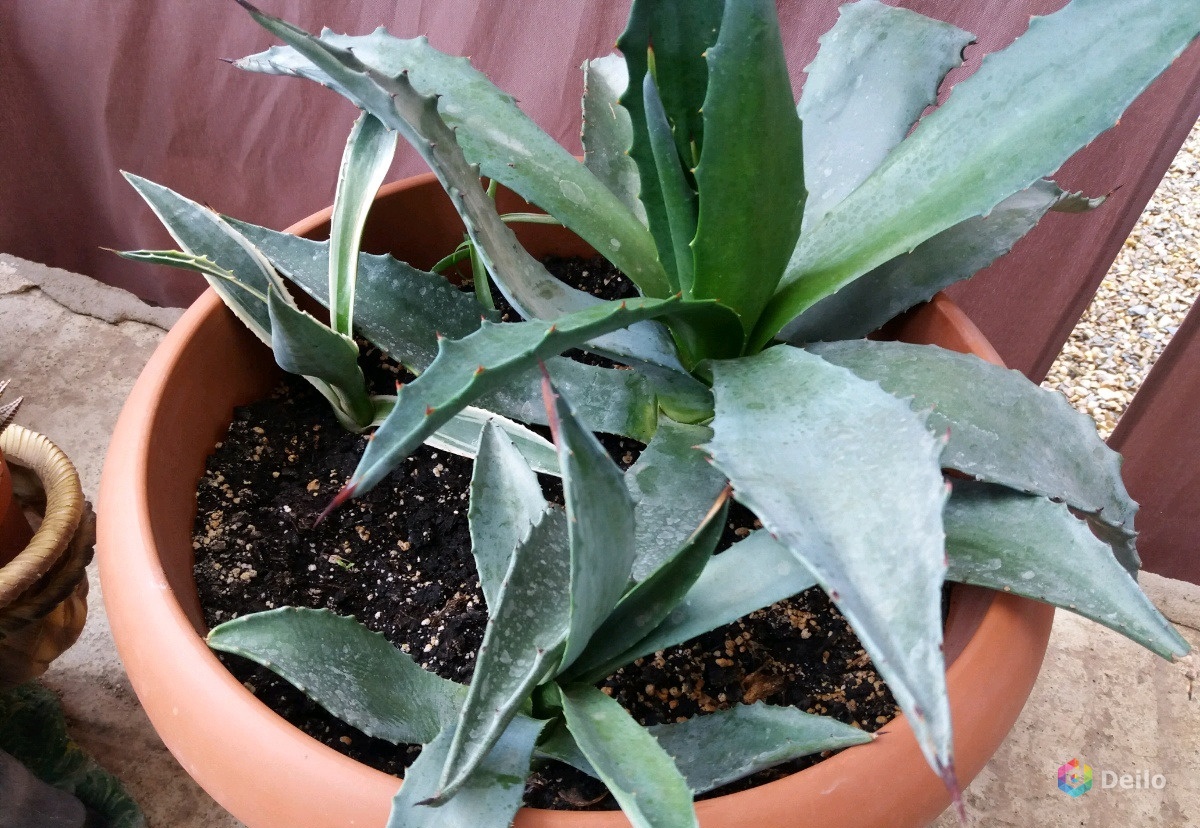
Agave babies
Jigging of children can be carried out at any warm season. At first, the pot with a seedling is not recommended to be exposed to the sun, the optimal place is a window facing east.
Sheet
Agave can be propagated by leaf in the same way. The sheet is broken off at the base, left to dry. You can sprinkle it with ash. After 2-3 hours, the leaf is inserted into the soil, where it will start up the first roots in 2-3 weeks. Rooting does not occur in the water of agave leaves, they begin to rot from excess moisture.
Peduncle
Under natural conditions, on agave plantations, the plant is propagated by peduncles, cutting down a palm tree at the base and sticking it immediately into the ground. Since at home, the flower almost never starts up peduncles, so it is better to use the methods described above.



